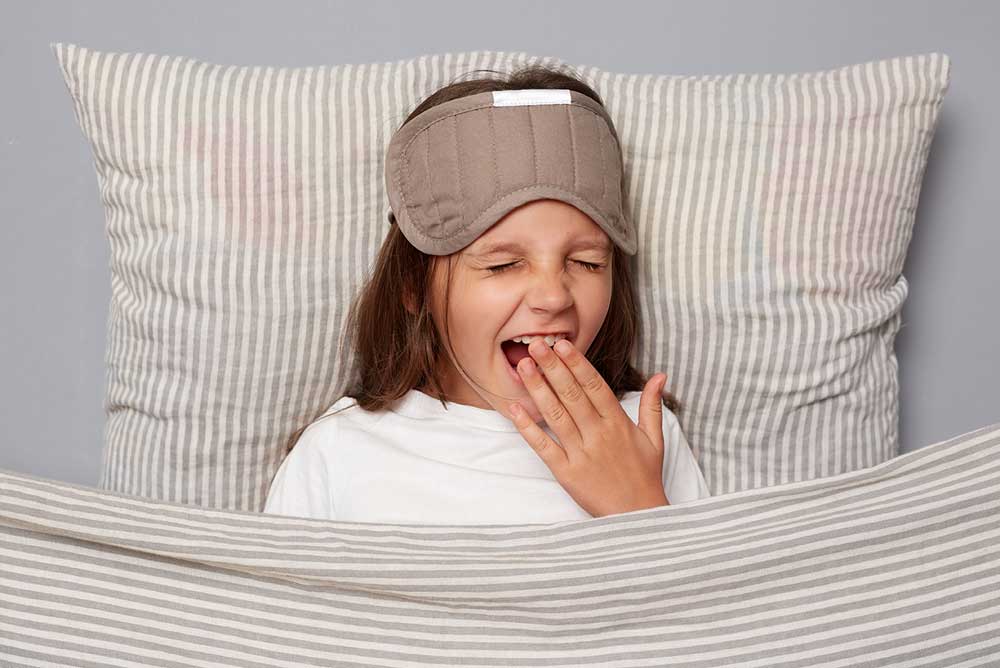
Is Your Child Getting Quality Sleep? Look for These Warning Signs
Child sleep breathing problems can make a child’s sleep a nightmare, affecting their daily life, behavior, and health. Identifying symptoms and warning signs early on is extremely important. Look for symptoms such as heavy snoring, waking often at night, and tiredness during the day.
Sleep and healthy airways are critical for children’s growth, learning, and overall health. Many children suffer from sleep-disordered breathing (SDB), a condition that can disrupt restful sleep and lead to a variety of systemic health and behavioral issues. Recognizing the signs of SDB early is key to getting your child the care they need so their growth and development can thrive.
Warning Signs of Sleep-Disordered Breathing in Kids
Keep an eye out for the following symptoms, which may indicate an underlying issue with your child’s breathing during sleep:
Breathing and Sleep Patterns
- Snoring more than 3 nights a week
- Noisy breathing, gasping, or pauses in breathing during sleep
- Restless sleep (frequent tossing, turning, or position changes)
- Sleeping in unusual positions (like hyperextended neck or sitting up)
- Mouth breathing, leading to dry mouth or inflamed gums
- Night sweats (a sign of increased effort to breathe)
Daytime Behavior and Health Issues
- Difficulty waking up in the morning or frequent daytime sleepiness
- Cognitive and behavioral concerns such as irritability, hyperactivity, mood swings, or trouble paying attention (sometimes mistaken for ADHD)
- Poor academic performance or being mislabeled as “lazy” or “slow”
- Frequent headaches, especially in the morning
- Stunted growth or failure to meet growth milestones
Other Associated Concerns
- Bedwetting (nocturnal enuresis)
- Bruxism (teeth grinding)
- Frequent tonsil, adenoid, ear infections, or nasal obstructions
- Nightmares or night terrors
- Paradoxical chest and abdominal movements during sleep
Understanding Sleep Breathing Problems
What Are Sleep Breathing Problems?
Sleep breathing problems in kids, usually characterized by snoring or heavy breathing, are not normal sleep. Collectively, these sleep disturbances, or sleep-disordered breathing, range from obstructive to central sleep apnea, among other presentations.
Obstructive sleep apnea (OSA) is a disorder marked by repeated episodes of breathing stopping while asleep due to the blockage of the upper airway. The main difference is in how frequent and serious the breathing breaks are.
How Common Are They in Children?
OSA prevalence is reported at approximately 3 to 6 percent of children, with the highest prevalence seen in ages 3 to 6. The prevalence may increase up to 10 to 20 percent in habitual snorers.
Why It’s Important to Act Early
Untreated sleep-disordered breathing can affect your child’s physical health, growth and development, emotional well-being, and academic success. Early evaluation can prevent long-term complications and help your child thrive.
When left untreated, sleep breathing problems can severely affect a child’s growth and their ability to concentrate and perform at school. Untreated problems can result in chronic health effects, such as cardiovascular disease.
How We Can Help at Milnor Orthodontics
As orthodontists, we’re uniquely equipped to assess structural and airway issues that may contribute to SDB. If your child exhibits any of the warning signs above, schedule a consultation with us. We’ll evaluate their airway, dental structures, and overall health to identify possible solutions—whether it’s an orthodontic appliance, collaboration with ENT specialists, or other treatments.
Let’s work together to give your child the healthy, restorative sleep they deserve!
Causes and Risk Factors
Sleep disorders in children often arise from various causes. Understanding these factors can help with early intervention and prevention.
Common Causes
- Enlarged tonsils and adenoids
- Genetic conditions affecting muscle tone or airway structure
- Respiratory infections impacting sleep quality
- Environmental factors like allergens and exposure to smoke
- Nasal obstruction or chronic congestion
Risk Factors in Children
Several factors can increase a child’s likelihood of developing sleep-disordered breathing:
- Obesity: A major risk factor that can significantly impact breathing during sleep
- Family History: Genetic predisposition to sleep breathing disorders
- Neurologic Conditions: Such as cerebral palsy that may reduce airway tone
- Structural Issues: Including jaw position and dental alignment problems
- Medical Conditions: Such as asthma or chronic allergies
Environmental Influences
Environmental factors can play a significant role in sleep-disordered breathing:
- Air quality and pollution levels
- Exposure to secondhand smoke
- Seasonal allergies and allergens
- High altitude living
- Room temperature and humidity levels
Understanding these causes and risk factors is essential for prevention and early intervention in sleep-disordered breathing. Parents who recognize these risk factors can work proactively with healthcare providers to monitor and protect their child’s sleep health.
Diagnosis and Evaluation
How Is Sleep Apnea Diagnosed?
It takes an extensive step-by-step process to get a true diagnosis. An important next step would be to perform a sleep study, or polysomnography (PSG).
This research study continuously tracks your sleep patterns, breathing, and other vital functions during the night. PSG continues to be the gold standard for diagnosing obstructive sleep apnea (OSA).
Treatment and Management
Treatment Options for Children
Several effective treatment options are available for children with sleep-disordered breathing:
- Orthodontic Treatment: Seeing an orthodontist like Dr. Milnor early in a child’s development can be crucial for addressing sleep-disordered breathing. Orthodontists can evaluate and treat underlying structural issues that affect breathing, such as a narrow palate, restricted airways, or improper jaw position. Using specialized orthodontic appliances and techniques, Dr. Milnor can help expand the palate, create more space for proper breathing, guide facial growth and development, and improve overall airway function. Early orthodontic intervention can often prevent the need for more invasive treatments later.
- Adenotonsillectomy (AT): This surgical procedure is a miracle cure for mild obstructive sleep apnea (OSA) in young, non-obese children. It comes with a jaw-dropping success rate of 80% plus! It is usually the first line treatment when a positive sleep study shows OSA.
- CPAP Therapy: Though effective, CPAP cannot be considered as a first-line treatment option due to cost and compliance issues. It’s usually only used in situations where surgery isn’t possible or would be ineffective.
- Lifestyle Changes: Addressing factors like obesity is crucial. Weight management plays a key role in the severity and management of sleep apnea.
Dr. Milnor will conduct a thorough evaluation to determine which treatment options are most appropriate for your child. We believe in a comprehensive approach that addresses both immediate symptoms and long-term airway health. Schedule a free consultation to discuss your child’s specific needs and create a personalized treatment plan.
Tips for Reducing Risk Factors
- Encourage nasal breathing to keep airways clear.
- Use a humidifier to ease nasal congestion.
- Ensure a healthy diet and regular physical activity.
- Teach kids to sleep on their backs.
- Schedule regular check-ups for professional monitoring.
Prevention Strategies
Proactive Steps for Better Sleep Health
- Create an Optimal Sleep Environment:
- Maintain a quiet, dark sleeping space
- Use a humidifier to ease nasal congestion
- Keep a consistent room temperature
- Establish Healthy Sleep Habits:
- Set consistent bedtimes and wake times
- Create a calming bedtime routine
- Limit screen time before bed
- Promote Healthy Breathing:
- Encourage nasal breathing to keep airways clear
- Teach proper sleep positioning
- Address allergies and nasal congestion promptly
- Regular Health Monitoring:
- Schedule routine dental and medical check-ups
- Monitor growth and development milestones
- Track sleep patterns and any changes in behavior
Lifestyle Modifications
Prevention through healthy lifestyle choices can significantly reduce the risk of sleep-disordered breathing:
- Maintain a healthy weight through proper nutrition and regular exercise
- Avoid exposure to secondhand smoke and other air pollutants
- Practice good oral hygiene and regular dental care
- Stay current with vaccinations to prevent respiratory infections
- Manage allergies and asthma effectively
By implementing these prevention strategies early, parents can help protect their children from developing sleep-disordered breathing issues. Early intervention and consistent monitoring remain key to maintaining healthy sleep patterns throughout childhood.
Prognosis and Long-Term Outlook
With early diagnosis and proper treatment, the long-term outlook for children with sleep-disordered breathing is excellent. At Milnor Orthodontics, we’ve seen countless children transform from restless, tired sleepers to energetic, well-rested kids through appropriate intervention and care.
What to Expect with Treatment
When you begin treatment for sleep-disordered breathing, benefits may be noticeable in just a few weeks. Children often experience:
- Improved sleep quality and duration
- Better daytime alertness and concentration
- Enhanced academic performance
- Improved mood and behavior
- Normal growth patterns
- Reduced risk of long-term health complications
Dr. Milnor’s expertise in airway orthodontics allows us to monitor these improvements and adjust treatments as needed for optimal results. Schedule a free consultation to discuss your child’s specific needs and treatment options.
Long-Term Success Rates
The success rate for treating sleep-disordered breathing is particularly high when addressed early. Many children show significant improvement after receiving appropriate treatment, especially when structural issues are corrected through orthodontic intervention. At Milnor Orthodontics, we take pride in helping children achieve not just better sleep, but better overall health and quality of life.
Ongoing Monitoring and Care
Regular follow-up care is essential for maintaining long-term success. Our team at Milnor Orthodontics provides comprehensive monitoring to ensure your child’s treatment remains effective as they grow and develop. We work closely with other healthcare providers to coordinate care and optimize outcomes.
Don’t wait to address your child’s sleep breathing concerns. Book your complimentary consultation with Dr. Milnor today to discuss how we can help your child achieve restful, healthy sleep for life.
When to Seek Medical Advice
Timely medical intervention is critical for suspected sleep apnea. If you experience symptoms such as loud snoring, gasping, or stopping breathing while sleeping, visit your doctor right away.
Daytime fatigue and behavioral concerns are big ones too. Listen to your gut—if you feel like something is not right, then it’s time to get an expert opinion.
At Milnor Orthodontics, our experts are here to help you achieve a priceless smile. Call our office at (970) 484-3214 or visit milnororthodontics.com to learn more. We're located at 1103 S. Shields St. in Fort Collins, Colorado.







